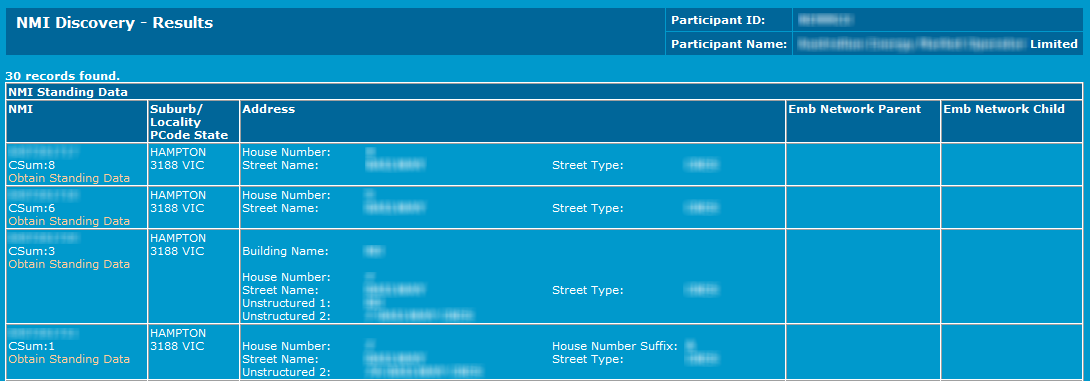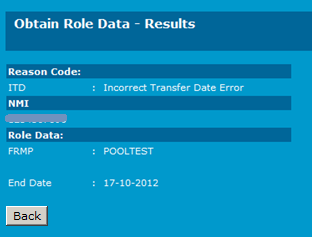NMI discovery
About NMI discovery
To learn more about NMI Discovery, see Technical Guide to MSATS.upa
From the NMI Discovery menu, you can:
- Discover a customer’s NMI See Relevant Rules or Procedures and checksum if it is not known such as, when the customer cannot provide it (search type 1).
- Discover sufficient Standing Data about the NMI to provide a customer with a quotation (search type 2).
- Identify the current or most recent previous Retailer See Relevant Rules or Procedures for a NMI (search type 3).
- Find a Meter's Previous Read Date and Quality Flag.
Search Type 1: NMI Discovery
NMI Discovery Search Key Rules may prevent access to certain search criteria, see Jurisdictional rules.
All Participant Users with appropriate access rights can use the NMI Discovery search type 1 provided their Participant ID Registered participant identifier; A company can have more than one Participant ID. is registered in MSATS Market Settlement and Transfer Solutions. The procedures published by AEMO under clause 7.2.8 of the National Electricity Rules, which include those governing the recording of financial responsibility for energy flows at a connection point, the transfer of that responsibility between market participants, and the recording of energy flows at a connection point. as acting in a Role The role a company has with a connection point in CATS. A single company can have more than one role associated with a NMI. allowed access to NMI Discovery.
The Participant User A Participant ID's users created and maintained by the Markets Portal PA in the URM. undertaking the search does not need to hold an existing participant Role Relationship against the NMI for Standing Data to be returned unless their Role is LNSP. LNSPs can only search their own NMIs.
Search Type 2: Obtain Standing data
Search Type 2 is the process of entering a NMI and checksum to locate Standing Data about the NMI.
When the NMI and checksum are known, a Standing Data search returns the data to assist Retailers to provide a quote to an End-use Customer and find Meter Read data information for the customer switching process.
Detailed information is returned regarding the NMI, based on the NMI Discovery Field Access Rules The National Gas or Electricity rules.. Information included is the Network Tariff Code A nominated code for the Network Tariff charged by the NSP., TNI code, DLF Distribution Loss Factor. The loss of energy, due to electrical resistance and the heating of conductors, as electricity flows through the transmission and distribution networks. code and information about the Metering configuration. These rules are governed by the NMI's Jurisdiction participating jurisdiction (defined in the NER).
Search Type 3: Obtain Role Data
Search Type 3 assists in the identification of the Current The participant can receive files compliant to the current aseXML version. or most recent previous Retailer for a NMI and allows Retailers to provide a reason for their request.
NMI Discovery user rights access
Participant Administrators control access to NMI Discovery using the NMI Discovery entity in the Administration menu in the MSATS Web Portal.
Jurisdictional rules
The type of information, search criteria and number of results returned from the NMI Discovery or Standing Data search is governed by the NMI Discovery Search Key Rules and the NMI Discovery Field Access Rules, both of which are defined by each participating jurisdiction. If the number of corresponding records is greater than the number of records the user is permitted to view, only the number of items within the limit are returned. To reduce the number of records returned, refine the search criteria.
Participant Users may have access to view the Jurisdictional rules, using the Administration menu. for help, see Administration.
If no NMI Discovery Search Key Rules or NMI Discovery Field Access Rules are defined for a jurisdiction, then it means that the jurisdiction has not allowed NMI Discovery for any NMIs in that jurisdiction.
There is also a further jurisdictional rule that determines whether, in the event of multiple matches, the address of each matching NMI is also returned. The rule is set to yes for all jurisdictions allowing NMI Discovery.
Using search type 1 (NMI Discovery)
The search type 1 (NMI Discovery) is used to discover the following NMI information when a limited amount of NMI Standing Data See National Electricitiy Rules is known:
- NMI identifier
- NMI checksum
- NMI Address The address where the connection point the NMI refers to is located (the site address). During a consumer transfer, this information is supplied to the new retailer by the LNSP and acts as a check for the correct NMI identification. Details
- LNSP
To use search type 1 (NMI Discovery):

- On the main menu, click NMI information and then click NMI Discovery.
- The NMI Discovery - Search interface displays, select the Search Type 1 (NMI Discovery).
- In the Jurisdiction drop-down list, select a Jurisdiction. This is a required field.
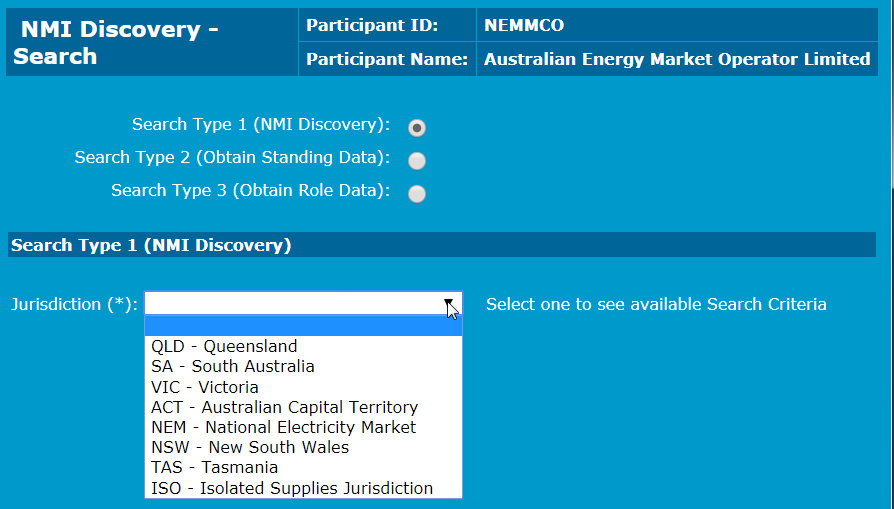
- Complete the fields in the search criteria and click Search. You can search by any of the following criteria:
- DPID
- Meter Serial ID
- Address (State, Suburb and/or Postcode fields are required for the address criteria)
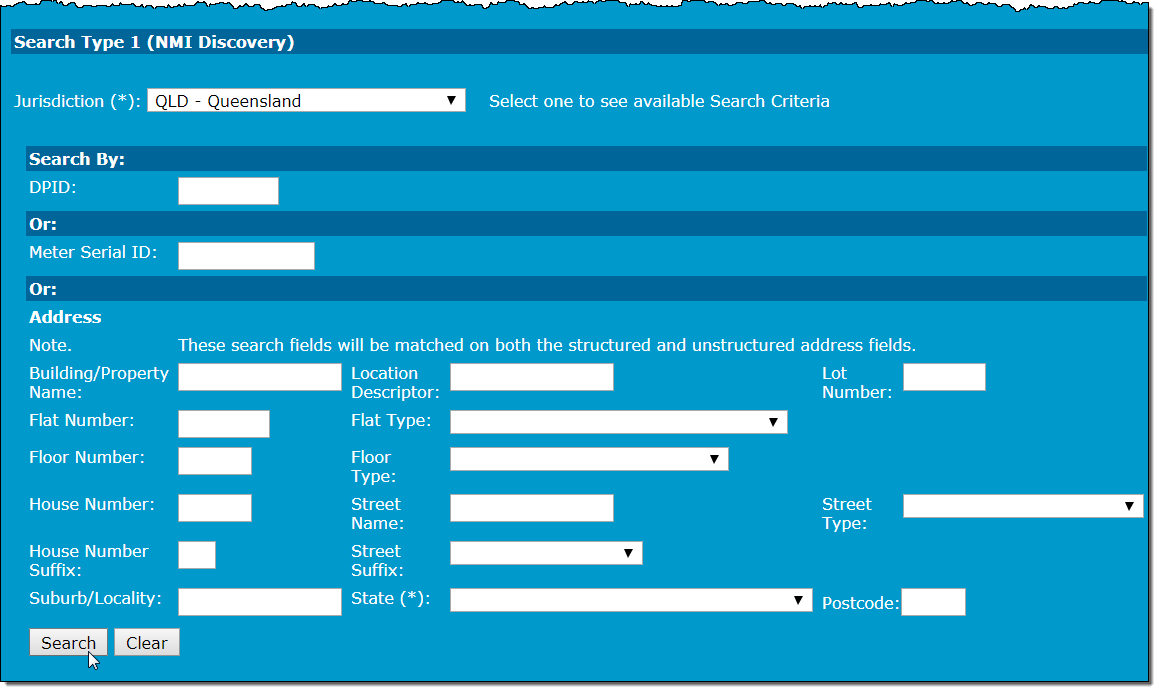
- The NMI Discovery - Results display. For an explanation on the returned search fields, NMI Discovery results explained.
- You cannot modify NMI information from the results interface.
If the data does not pass validation, or if a required field is blank, an error message displays.

- To access additional NMI information, click Obtain Standing Data in the NMI column.
If the result of a search exceeds the amount set for the Jurisdiction, the following message displays, “”.
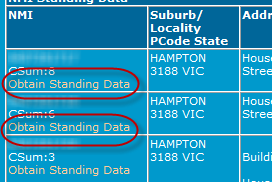
- The read-only Obtain Standing Data - Results interface displays. This information is the same as search type 2 - Obtain Standing Data.
- For more NMI information, click one of the links in the Go To field:
- View Datastreams (see page 1).
- View participant relationships (see page 1).
- View Meter Registers (see page 1).
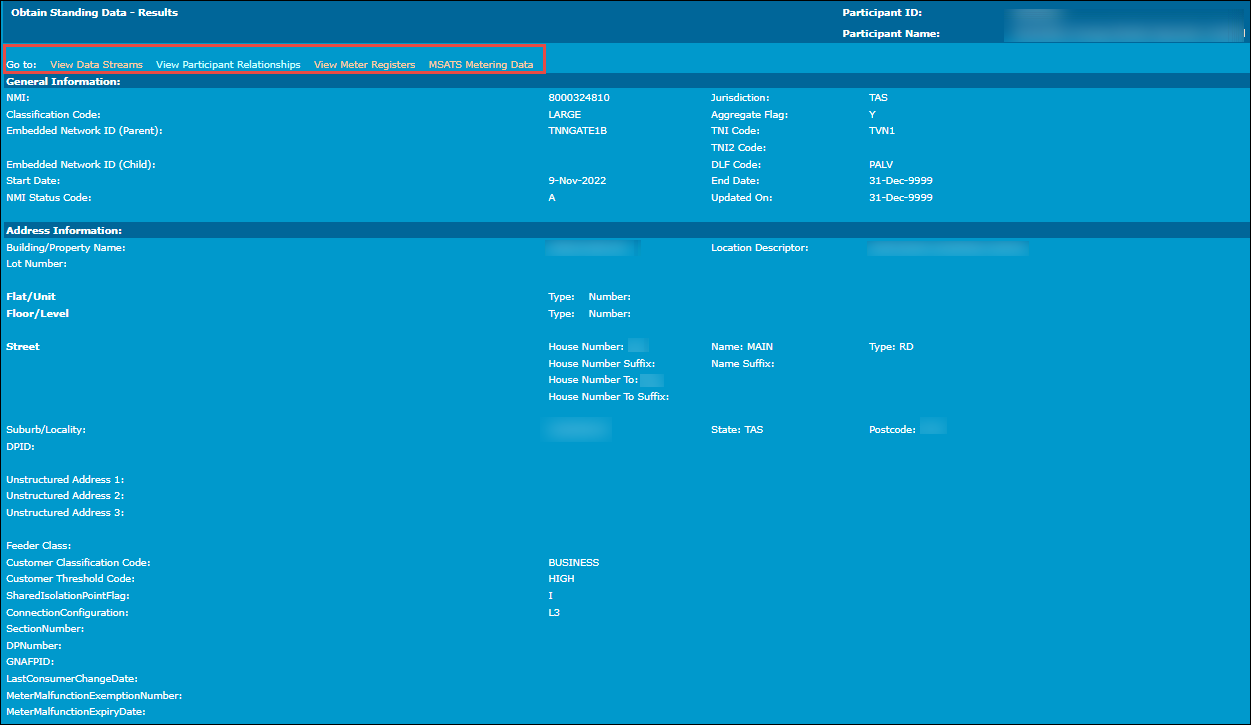
Using search type 2 (obtain standing data)
The following steps provide an identical result to selecting the Obtain Standing Data link from search type 1 (NMI Discovery) results.
The search type 2 (obtain Standing Data) is used when the NMI and checksum are known.
To use search type 2 (obtain Standing Data):
- The NMI Discovery - Search displays, select Search Type 2 (Obtain Standing Data).
- Enter both the NMI and the 1 digit Checksum and click Search.
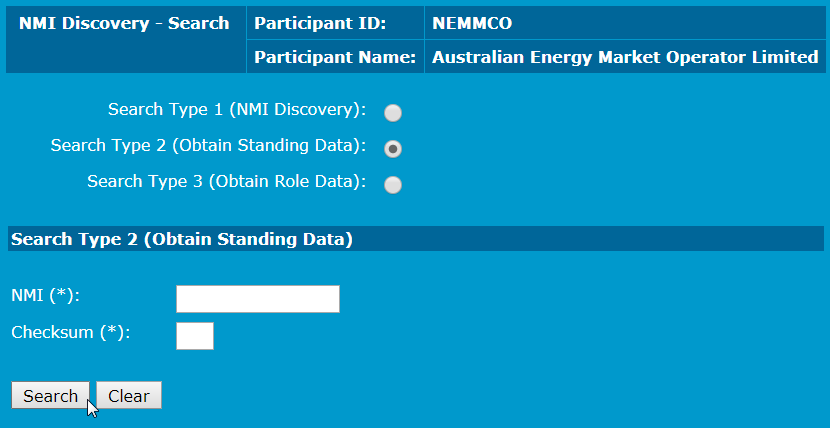
NMI information cannot be modified from the results interface.
- The read-only Obtain Standing Data - Results displays.
- If there is no matching NMI, a message displays "".
- For an explanation on the returned search fields, NMI Discovery results explained.
- For more information, click one of the links in the Go To field:
- View Datastreams (see page 1).
- View participant relationships (see page 1).
- View Meter Registers (see page 1).
- View MSATS Metering Data (see page 1)
Figure 103 Obtain standing data results
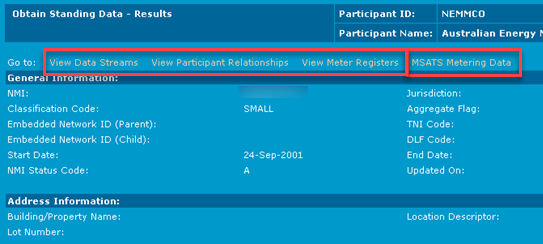
Using search type 3 (obtain role data)
NMI Discovery search type 3 - obtain Role data assists in the identification of the current or most recent previous Retailer for a NMI and allows Retailers to provide a reason for their request.
Some search rules are:
- Correct Retailer: The Retailer that should be listed as the FRMP Financially Responsible Market Participant, usually a retailer, Generator, Market Customer or a Market Small Generator Aggregator, identified in respect of a connection point. Responsible for dealings with AEMO in relation to a specific load. for the NMI in MSATS. They are the end-use consumer’s chosen Retailer.
- Current Retailer See current FRMP or current FRMP: The Retailer who is currently listed with an active Role of FRMP for a NMI in MSATS.
- Most recent previous Retailer: The Retailer who was the FRMP before the NMI was transferred to the party listed as the current FRMP in MSATS.
To use search type 3 (Obtain Role Data):

- On the NMI Information menu, click the NMI Discovery submenu.
- Select Search Type 3 (Obtain Role Data) and complete the mandatory Reason, NMI, and Checksum fields, and then click Search.
Figure 104 Search Type 3 reason codes
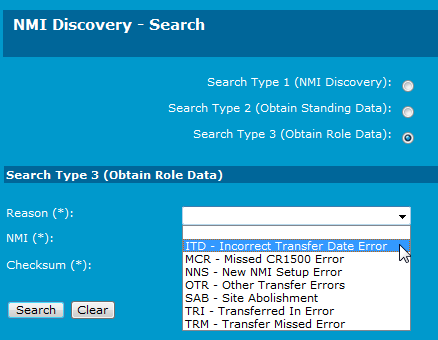
- The results display similar to the ITD reason code example below.
If the request returned no data, as in the case when a NMI was recently created and no previous FRMP exists, then a “No data found” message displays.

Viewing datastreams
To view Datastreams:
- Follow the steps to obtain Standing Data, Using search type 1 (NMI Discovery) or Using search type 2 (obtain standing data).
- On the Obtain Standing Data - Results interface, click View Datastreams.
- The NMI Datastreams - List interface displays each Datastream associated with the connection point (NMI).

Viewing participant relationships
To view participant relationships:
- Follow the steps to obtain Standing Data, Using search type 1 (NMI Discovery) or Using search type 2 (obtain standing data).
- On the Obtain Standing Data - Results interface, click View Participant Relationships.
- The NMI Participant Relationships - List interface displays each participant relationship for the connection point (NMI).

Viewing meter registers
To view meter registers:
- Follow the steps to obtain Standing Data, Using search type 1 (NMI Discovery) or Using search type 2 (obtain standing data).
- In Obtain Standing Data - Results, click View Meter Registers.
- The NMI Meter Registers - List interface displays a list of all meters and related information for the connection point (NMI). Click View in the Actions column to see further information.
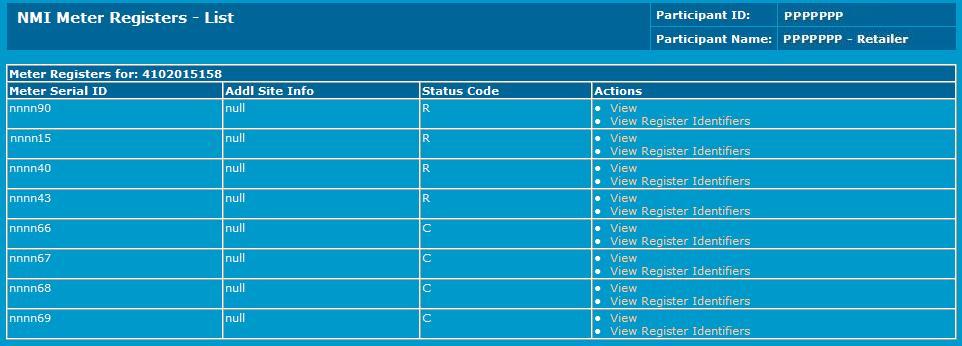
- The NMI Meter Register - View interface displays.
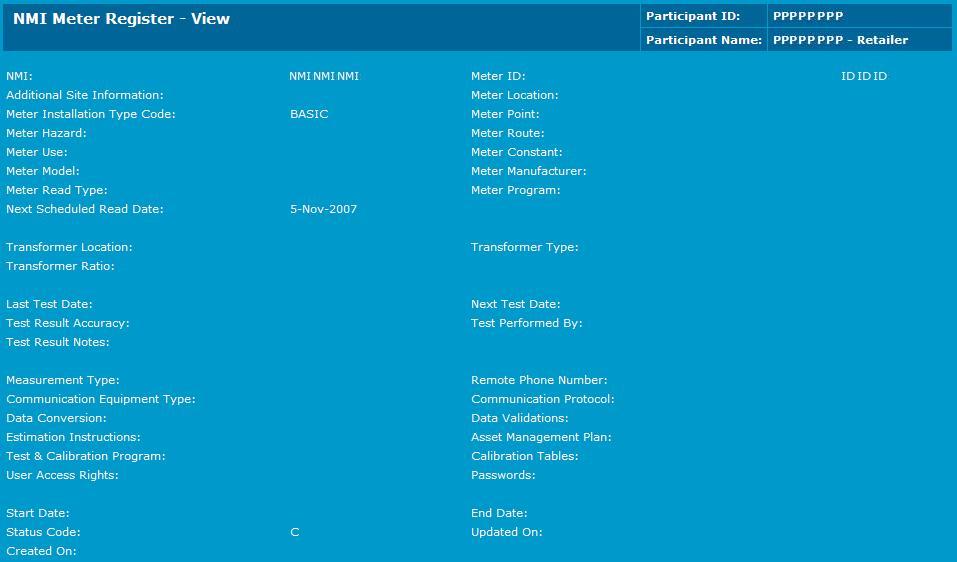
- Return to the NMI Meter Registers - List interface and then click View Register Identifiers in the Actions column.

- The NMI Register Identifiers - List interface displays, click View in the Actions column to see individual register information.
- The NMI Register Identifier - View interface displays individual register information.
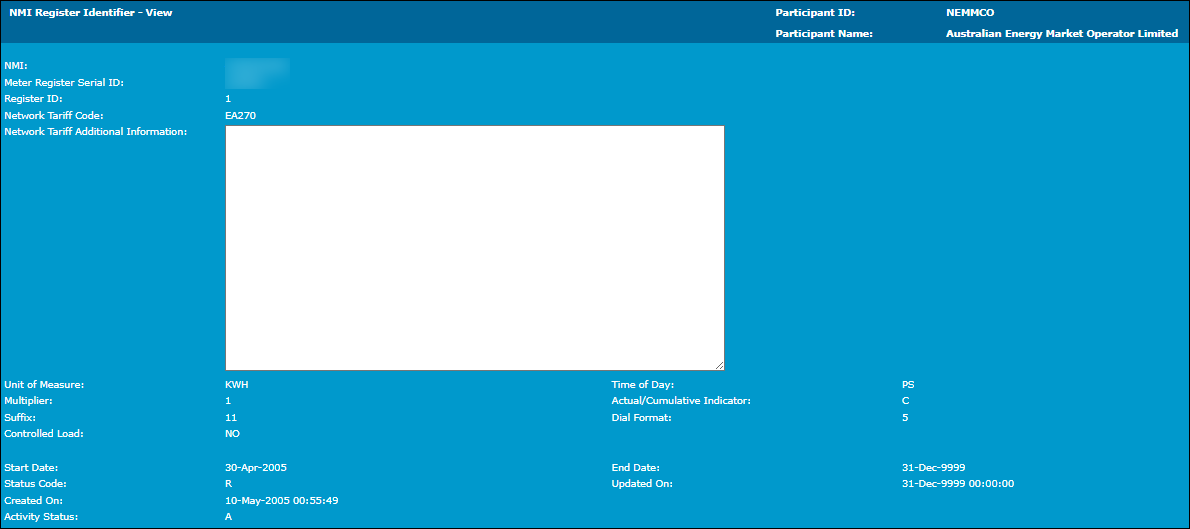
Viewing Metering Data
For details about the Previous Read Date (PRD) and Quality Flag process, see Technical Guide to MSATS.
You can also obtain this information using the getNMIDetail API.
To view MSATS Metering Data:
Follow the steps for Using search type 2 (obtain standing data).
In Obtain Standing Data – Results, click MSATS Metering Data (Obtain standing data results).
The interface displays the following details:
- NMI
- Previous Read Dates
- Associated Quality Flags

If previous reads are unavailable, one of the following messages display with the reason:

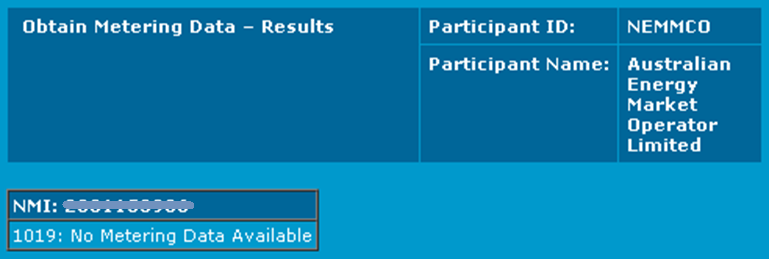
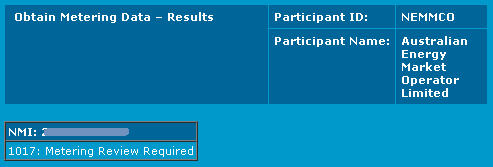
NMI Discovery results explained
For a detailed explanation of MSATS data, see Standing Data for MSATS.
Table 44 Explanation of NMI Discovery results
Field | Description |
|---|---|
Actions | The action values for meter exemptions and NMIs |
Actual or Cumulative Indicator (ActCumInd) | Actual implies volume of energy actually metered between two dates. Cumulative indicates a meter reading is required to determine the consumption between those two read dates. For an interval meter, ActCumInd normally = A |
Activity Status | Activity status for NMIs |
Aggregate Flag | Used by MDM to determine which Settlement report the data goes into |
Average Daily Load | The electrical energy delivered through a connection point or Metering point over an extended period normalised to a “per day” basis (kWh) |
Building or Property Name | The full name used to identify the physical building or property as part of its location |
Classification Code | Defines the NMI’s size e.g. SMALL or LARGE. Used to enforce validation on a number of rules tables |
Customer Classification Code | Classifies the customer as BUSINESS or RESIDENTIAL Set by the FRMP for the NMI |
Customer Threshold Code | Classifies the customer load as LOW, MEDIUM, or HIGH Set by the DNSP for the NMI |
Controlled Load | Indicates whether the energy recorded by this register is created under a controlled load regime. Controlled Load field contains “No” if register does not relate to a controlled load and contains a description of the controlled load regime. |
Datastream Type | Indicates the type of data the Datastream reports, includes Interval and Accumulation. This value must be either “I” (interval), “C‟ (basic) or “P‟ (profile) |
Dial Format | Describes the register display format. First number is the number of digits to the left of the decimal place, and the second number is the number of digits to the right of the decimal place |
DLF Code | Distribution Loss Factor code. The DLF is used to scale a metered quantity from the Metering location to the relevant Transmission Network Connection point |
DPID | Delivery point identifier - the numeric descriptor for a postal delivery point, which is equal to a physical address. This is an Australia Post assigned number |
Embedded Network ID (Child) | Identifies which embedded network this NMI is the ‘child of’. If this field is blank, then the NMI is not in an embedded network |
Embedded Network ID(Parent) | Identifies which embedded network this NMI is the ‘parent of’. If this field is blank, then the NMI is not a parent of any other NMI |
End Date | The date until which data in the record applies. (This is not the date the record was updated.) If the end date is 31-Dec-9999, it means that the data in this record applies into the future |
Flat or Unit Number | Specification of the number of the flat or unit |
Flat or Unit Type | Specification of the type of flat or unit that is a separately identifiable portion within a building or complex (for example, Apartment) |
Floor or Level Number | Floor Number is used to identify the floor or level number of a multi-storey building or complex |
Floor or Level Type | Floor type is used to identify the floor or level of a multi-storey building or complex |
House Number | The numeric reference of a house or property. Specifically the house number |
House Number Suffix | The numeric reference of a house or property. Specifically the single character identifying the house number suffix. |
Jurisdiction | Jurisdiction to which the NMI belongs |
LNSP | Local Network Service Provider |
Location Descriptor | A general field to capture various references to address locations alongside another physical location |
Lot Number | The lot reference number allocated to an address prior to street numbering |
MDP | Meter Data Provider |
Meter Serial Number | A unique serial number for a given NMI |
Meter Status | A single character code to denote the status of the meter within the NEM |
MeterMalfunctionExemptionNumber | The NMI flag indicating that exemption number exists |
MeterMalfunctionExpiryDate | The NMI flag indicating the end date of an exemption |
MPB | Meter Provider - Category B |
MPC | Meter Provider - Category C |
Multiplier | Multiplier taking a register value and turning it into a value representing billable energy |
Network Tariff Code | Code supplied and published by the LNSP |
Network Tariff Additional Information | Include additional information pertinent to Network Tariff Code supplied and published by the LNSP |
Next Scheduled Read Date | Next scheduled read date of the meter |
NMI | National Metering Identifier |
NMI Status Code | Status codes for NMIs |
Postcode | The numeric descriptor for a postal delivery area, aligned with locality, suburb or place |
Previous Read Date (PRD) | The date of a previous Meter Reading |
Profile Name | A code identifying the name of the algorithmically derived shape used to allocate a Datastream's consumption to trading intervals |
Quality Flag | Determines the quality of the Metering Data |
Register ID | Meter register ID |
Register Status | A single character lookup code indicating if the register is active |
Start Date | The start date from which the data in a record applies. (This is not the date the record was created.) |
State | Defined State or Territory abbreviation, for example, NSW |
Status Code | Code used to indicate the status of the NMI. To learn more, Administration |
Stream Status Code | Code used to indicate the status of the suffix. This value must correspond to a valid stream status code in the MSATS_Codes_Values_table |
Street Name | Records the thoroughfare name, excluding its type |
Street Name Suffix | Records any street suffixes, for example, SW, NE |
Street Type | Records the street type abbreviation, for example, ST or RD |
Suburb or Locality | The full name of the address locality |
Time of Day | Industry developed codes to identify the time validity of register contents |
TNI Code | Transmission Node Identifier; identifies the Transmission Network Connection Point |
Unit of Measure | Code to identify the Unit of Measure (UOM) for data held in this register |
Updated On | The date when the data of the record is updated |
NMI data returned (multiple matches)
Detailed NMI information is provided to Participant Users when there are single or multiple matches returned on a NMI Discovery search. In addition to providing the NMI and the NMI checksum, MSATS returns the following address fields from the CATS Customer Administration and Transfer Solution. A set of procedures, principles and obligations made under the National Electricity Rules as part of Market Settlement and Transfer Solutions (MSATS), and applicable to NMI (National Metering Identifier) small and large classifications._NMI_DATA table, provided the jurisdiction has authorised the return of the address details:
Flat Type | Flat Number | Floor Type |
Floor Number | Building Name | Location Descriptor |
House Number | House Number Suffix | Lot Number |
Street Name | Street Type | Street Suffix |
Locality | State | Postcode |
DPID Number | EmbNet Parent | EmbNet Child |
These fields are returned on NMIs where there are single or multiple matches, and shown when the NMI Discovery is executed using the web portal or the batch handlers. The address details are provided to help a Prospective Retailer Retailer who may initiate a defined B2B process on the basis that they are in the process of applying for responsibility of a given site (using the Customer Transfer process in MSATS). narrow-down the search in the event of multiple matches.
